The AMD Llano Notebook Review: Competing in the Mobile Market
by Jarred Walton & Anand Lal Shimpi on June 14, 2011 12:01 AM ESTPower Gating
With 1.45 billion transistors on die, Llano relies on extensive power gating in order to keep things in order. The APU is split into two independent power islands: the CPU and the GPU. The memory controller and North Bridge both live on the GPU's power island. Each island has its own independent voltage source.
Everything from an individual CPU core to the entire GPU or virtually the entire APU package can be power gated. AMD provided photon recombination images to show the impact power gating the GPU can have on leakage current:
Although not depicted above, Llano can also fully power gate the x86 CPU cores or both the CPU and GPU if the entire APU is in a deep sleep state. Being able to completely power gate CPU cores or the GPU is an important part of enabling the next major feature of Llano: Turbo Core.
Turbo Core
All processors whether CPUs, GPUs or APUs have to be designed to strict thermal and power limits. OEMs need to know exactly what sort of chassis they'll be able to build around these chips and as a result the chip vendors provide guidance in the form of specifications, including the chip's thermal design point (TDP).
In the old days of microprocessors things were simple. You had a single core that ran all the time and it consumed all of the available thermal budget allocated for that core. AMD and Intel eventually enabled dynamic clock frequencies which let your single core underclock itself when it wasn't being used, which helped reduce power and extend battery life. Then came the multi-core era.
CPUs couldn't just start putting out twice as much heat now that they had two cores; instead, each core had to consume less power. The chip guys achieved this by running the cores at lower frequencies and voltages than they did in the single-core days. Two cores paved the way to four cores, which meant another reduction in clock speed per core. Sure we got much better multi-threaded performance, but for single-threaded applications performance wasn't as great as it could be. Users had to make a tradeoff: good multi-threaded performance or good single-threaded performance; you couldn't have both. Until power gating came along that is.
Without power gating you can never really shut off power to an idle core. The transistors aren't switching but power is still dissipated thanks to leakage current. Remember that transistors don't simply stop conducting electricity when they're off. The smaller they get, the more leaky our beloved transistors become. Power gating lets you physically block the flow of current to the transistors that are being gated, so when they're off, they're actually off. With an idle core shut off, now you have the extra TDP headroom to run any active cores at higher frequencies.
Intel does this with a technology it calls Turbo Boost. Intel looks at current draw and thermal sensors spread out all over the chip and determines when it has the available thermal headroom to turbo up any active cores. AMD implements a similar technology in Llano (and previously in their hex-core desktop parts) called Turbo Core.
I say similar but not identical because AMD's approach differs in a very important way. While Intel looks at current draw and temperature data, AMD looks at workload. Each activity within the Llano APU is assigned a certain power weight (e.g. an integer multiply is known to require a certain amount of power). Llano is aware of the operations it's currently working on and based on the weights associated with these operations it comes up with a general estimate of its power consumption on a per core basis. I mention this is an estimate because it correlates digital activity to power consumption; it doesn't actually measure power consumption.
Based on the number of events and their individual weights, AMD estimates the power consumption of each core and determines how much TDP headroom exists in the system. If the OS is requesting the highest p-state from the CPU and there's available TDP headroom, Llano will turbo up any active cores up to a maximum frequency. Like Sandy Bridge, Llano is able to temporarily exceed the APU's maximum TDP if it determines that the recent history of power consumption has been low enough that it'll take a while for the APU to ramp up to any thermal limits.
One major limit of Llano's Turbo Core is that the GPU can't turbo up in the event of the CPU cores being idle. Only the CPU cores can turbo up if they have available headroom. I suspect future versions of Llano will probably enable GPU Turbo Core as well:
It's unclear to me at this point what shortcomings or advantages exist for AMD's Turbo Core method vs. Intel's Turbo Boost. At the bare minimum the two are finally comparable although they use different approaches to attain a similar end result. AMD doesn't yet have a method of actually displaying Turbo Core frequencies, unfortunately, so we're operating a bit blind at this point. Over time I hope to have a better idea of how AMD's solution stacks up.


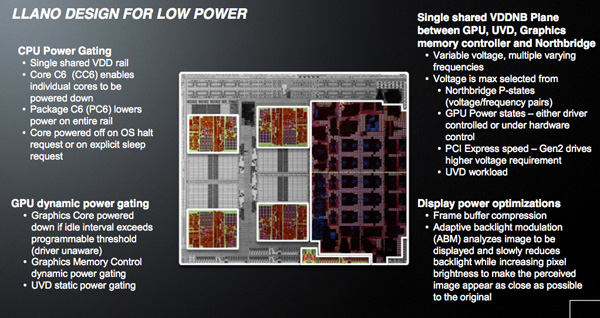
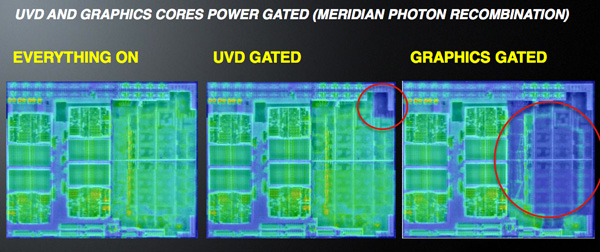
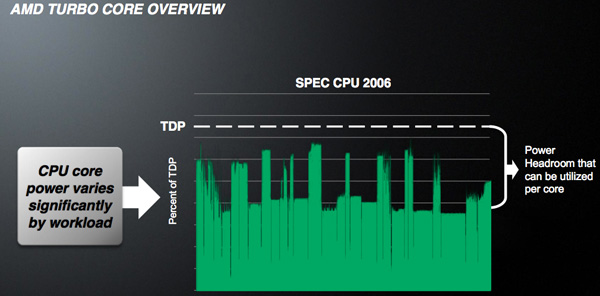
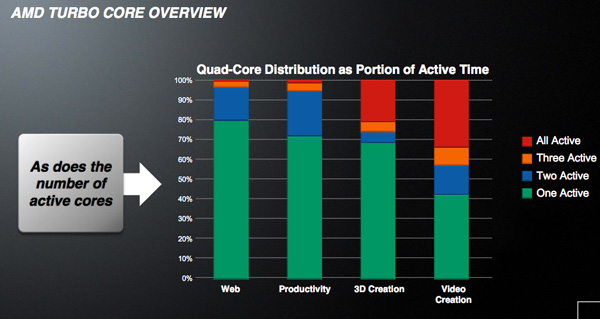
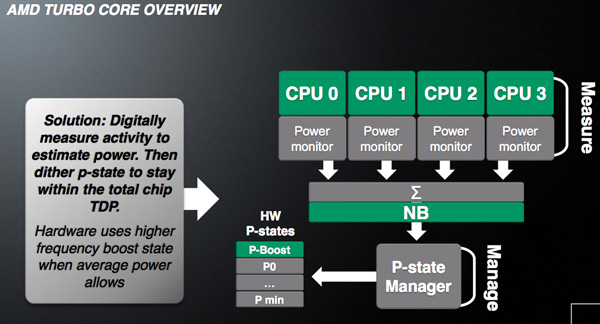
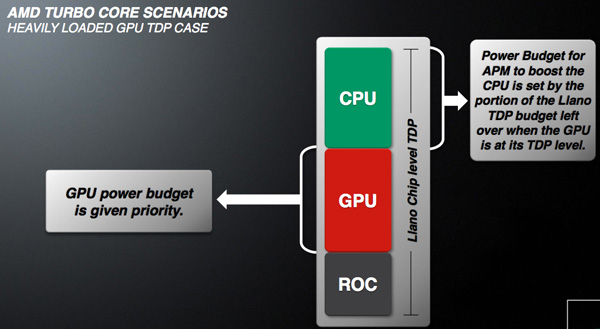
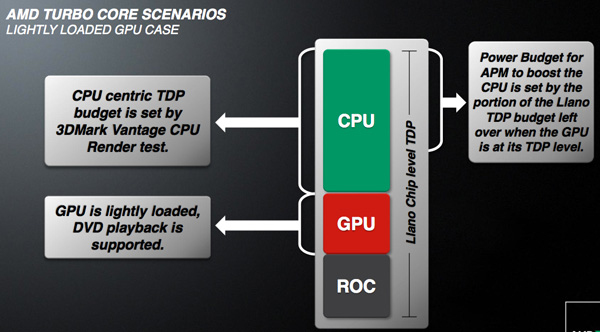








177 Comments
View All Comments
ionave - Thursday, June 16, 2011 - link
I'm honestly sick of the fact I can't play TF2 on high settings on my laptop AND I cannot find an affordable computer to do so while I'm not paying attention during class. Several people I know feel the same way.krumme - Tuesday, June 14, 2011 - link
The GPU performance hits dues to the shares bus is very low. Getting NV 540 /ati 5650 performance is far better than most expected.Battery life is simply amazing. Far better than expected.
The OEM is standing at a very long line for this.
GeorgeH - Tuesday, June 14, 2011 - link
That battery life is incredibly impressive. That AMD will finally have a competitive mobile offering is huge news; their engineers definitely deserve a pat on the back. Let's just hope that OEMs don't mess things up by cutting costs and shipping Llano laptops with tiny batteries.Unfortunately AMD will almost certainly struggle to get the message across that their CPU performance deficit is pretty much irrelevant for the vast majority of mobile usage models. It'll be especially difficult to get across to the huge number of consumers that think a 2GB 6570 is better than a 768MB GTX 460, but I wish AMD's marketing department the best of luck.
Dribble - Tuesday, June 14, 2011 - link
They'll struggle because cpu performance deficit does matter, cpu performance matters more then gpu performance for most of us. While llano might be *enough* today everyone buys a notebook and expects it too last several years.If llano currently only has the performance of a notebook several years old (core 2 intel) then you can bet in 3 years it'll be dog slow.
Really its only a winner for a pretty small margin of people. If you don't really care about gaming you go intel because cpu's are faster, if you really care about gaming you go intel + discrete. That leaves those who really care about gaming but are on an extremely tight budget.
ET - Tuesday, June 14, 2011 - link
I think that you underestimate the effect of price. If you really care about gaming you go desktop, anyway. If you want a reasonable size laptop with good battery life and capable of some gaming, Llano will fit the bill, and if it sells considerably lower than the competition, then I'm sure a lot of people will buy it. It won't be anyones main gaming rig, but it will surely serve many as a secondary one.I agree that Llano is disappointing at the CPU level, but it really should be enough for most people. How well it sells will depend on pricing. There are big E-350 laptops being sold, which boggles the mind, and there wouldn't be if all people really cared or had any clue about performance.
ppeterka - Tuesday, June 14, 2011 - link
I strongly disagree with you. My first notebook was exceptionally crappy in terms of raw CPU power. Desktop P4 Celeron 2.6GHz was used to power it. Yet I could use it for more than 4 years, after which I changed the CPU to a 2.8GHz P4, only to discover that the "user experience" was left unchanged except of the rare cases when I used the computer to work on it. Compile times were not left unchanged...But even with the Celeron in, the casual usage was just fine. Why? Because of the quite nice VIA IGP in it. I could actually play GTA San Andreas on the poor thing - even though there were times it was not very much fun, but it did work. Swapping the CPU didn't make it much better, only considering work duties.
Today "everything" is about multimedia. By "everything" I mean 80% of what the people are doing. Youtube, Facebook, who-knows-what, all. None of my friends ever regretted heeding to my advice to choose a notebook with a reasonable graphics solution even when there would be an altenative type with a stronger CPU. (of course not to the extremities). Granted, they were not primarily interested in scientific calculations, or heavy duty software development.
Dribble - Tuesday, June 14, 2011 - link
Multimedia doesn't need llano's gpu - SB graphics accelerates video just fine. Hence why you are recommending something that has better 3D graphics performance they'll never use, over something with a faster cpu which they will use all the time?GeorgeH - Tuesday, June 14, 2011 - link
You claim that CPU performance matters. That's true, but can you answer the following -1) Consider two laptops side by side. One has a ~2.5GHz C2D, one has a quad-core Sandy Bridge. Name a single task more than 5% of mobile users run that would allow you to definitively tell which laptop is running the C2D and which has the SB. (Task Manager doesn't count, I'm talking actually using an application.)
2) Name a single task or application that theoretically might let you do the above once it's widespread in the next 3-5 years.
3) What percentage of laptops are sold for <$1000 with roughly Llano or below levels of graphics?
4) What percentage of laptop buyers care about battery life?
My answers are -
1) No clue
2) No clue
3) Most of them
4) Most of them
That's why I say that Llano's battery life is huge and its CPU performance really doesn't matter. Even Intel agrees, which is one reason why you're seeing them move towards lower-power CPUs. Ivy Bridge will have "configurable" TDP, and Haswell will move from 35-35W to 10-20W:
http://www.anandtech.com/show/4378/ivy-bridge-a-ti...
RussianSensation - Tuesday, June 14, 2011 - link
3) The fact is you can get a laptop with better GPU performance and faster CPU performance for $700-750 on the Intel side:i5 480 + HD5730 for $700:
http://www.newegg.com/Product/Product.aspx?Item=N8...
i5 480 + GT 540M (which beat 6620 in almost every gaming benchmark in this review) for $700:
http://www.newegg.com/Product/Product.aspx?Item=N8...
i5 480 + HD6550M for $700:
http://www.newegg.com/Product/Product.aspx?Item=N8...
i5 2410 + GT 540M for $750:
http://www.newegg.com/Product/Product.aspx?Item=N8...
Every single one of these provides faster CPU & GPU performance (http://www.notebookcheck.net/Mobile-Graphics-Cards...
So Llano A-8 would need to be less than $700.
GeorgeH - Tuesday, June 14, 2011 - link
Can you find faster GPUs for <$1000? Sure, but that wasn't the question. Go to Dell or HP's website and look at the number of laptops priced under $1000, then look at the percentage of those that come with significantly better than Llano-level graphics.There's much more to determining the value of a laptop than raw CPU and GPU performance; you could easily pay more than $700 for a Llano laptop and still be getting a very good deal.
I'm not saying whether or not Llano should target this or that price point, though - I'm just trying to give a little perspective.